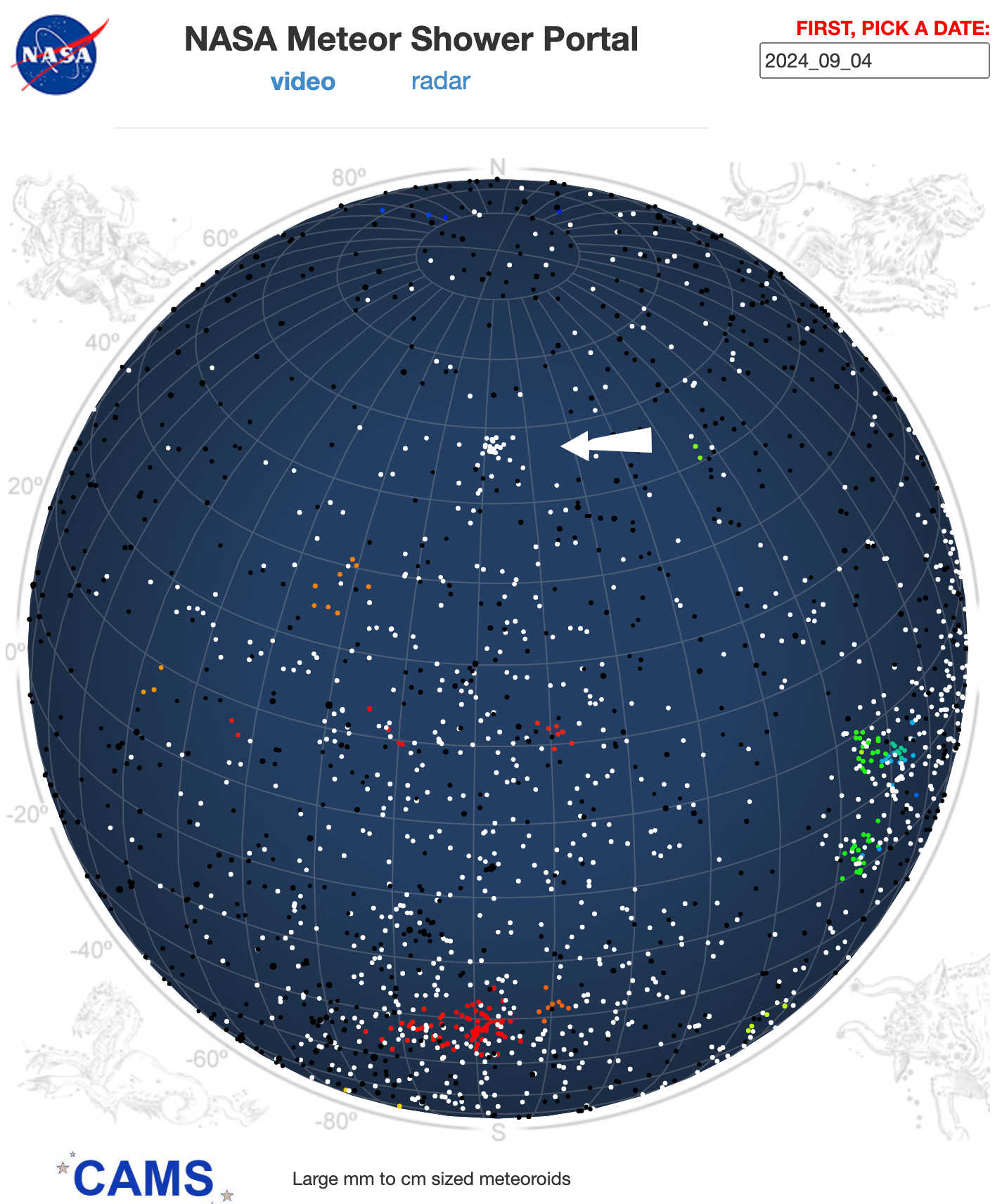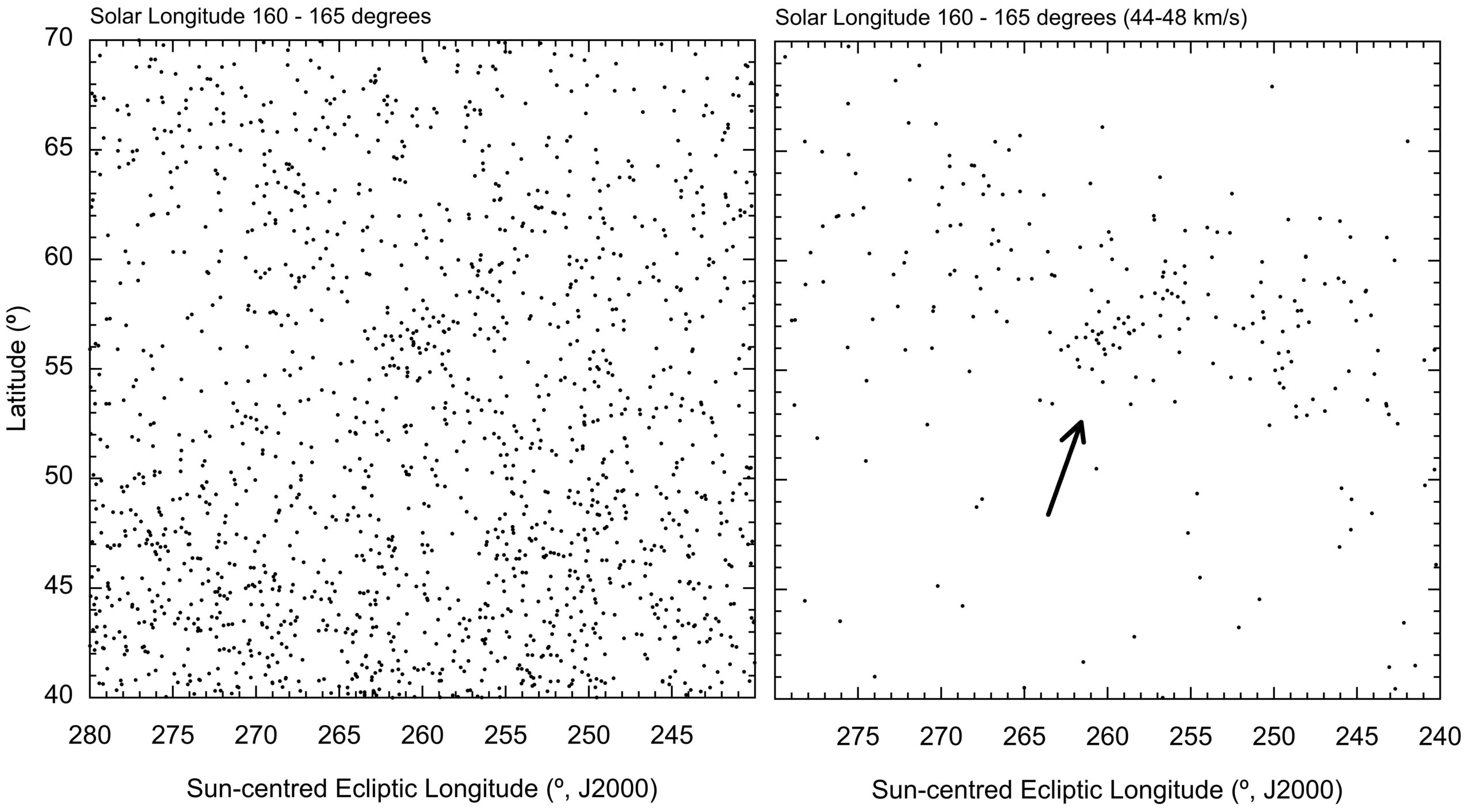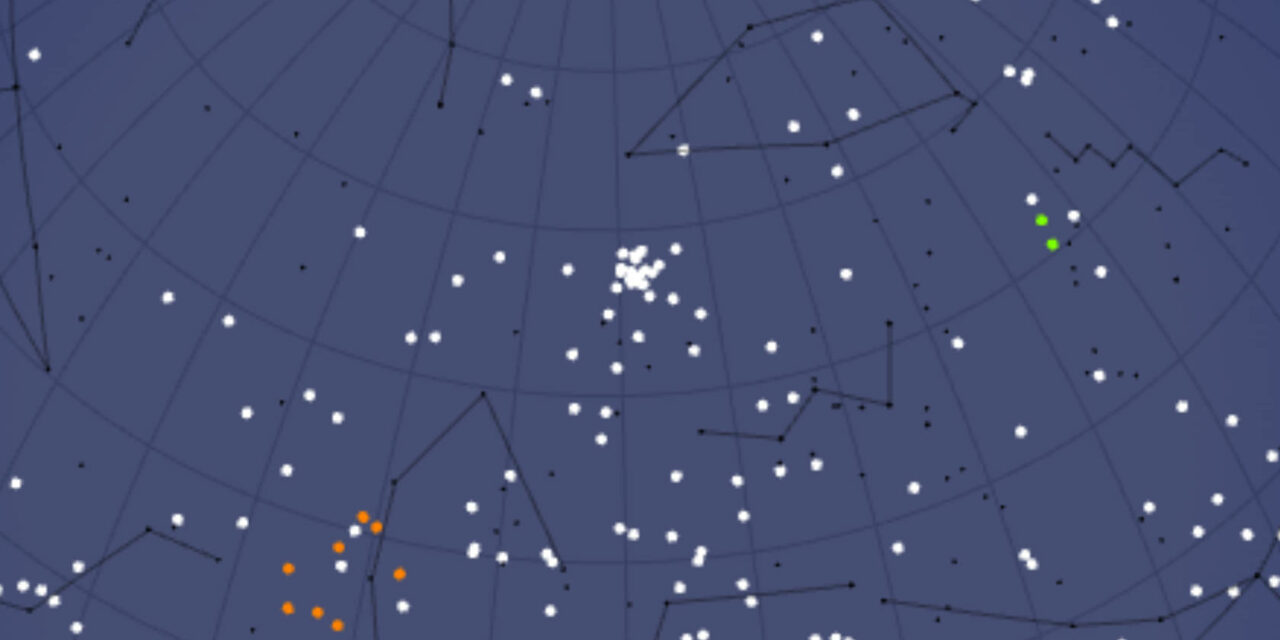By: Peter Jenniskens (SETI Institute), Nick Moskovitz (Lowell Observatory)
Abstract: A meteor outburst was detected by low-light level video camera networks in Arizona and California on September 4, 2024. The outburst was of short duration. Past data show a weak annual shower at these coordinates, which stands out from the nearby sporadic meteors by having a slightly lower entry speed. The shower was in outburst before in 2014.
Introduction
Now the main annual showers have mostly been mapped (e.g., Jenniskens, 2023), ongoing meteoroid orbit surveys by low-light video camera networks aim to document unusual meteor shower activity. One such unexpected meteor outburst with a radiant in the constellation Cassiopeia was detected on 2024 September 4 (Jenniskens & Moskovitz, 2024). It revealed the existence of a weak shower that had not been mapped yet. The provisional name for this shower proposed here is September psi-Cassiopeiids (SPC).
Observations
The CAMS California network is managed by station operators Eric Egland (Fremont Peak Observatory), Jim Albers (Sunnyvale), Bryant Grigsby (Lick Observatory), Jim Wray (Foresthill), and Tim Beck (Windsor, Ukiah, and Kelseyville). The Windsor station was recently moved to a new location in Cotati, just south of Santa Rosa. At the time of the outburst, the Fremont Peak Observatory station was down for maintenance.
The Lowell Observatory CAMS network (LO-CAMS) consists of four stations at Lowell Observatory in Flagstaff, at the Lowell Discovery Telescope, at the Meteor Crater (Nick Moskovitz, Sam Hemmelgarn), and at the Embry Riddle Aeronautical University (ERAU) in Prescott. The ERAU CAMS station, operated by Brian Rachford, is down at the moment awaiting repairs. In addition there are several 6-camera Global Meteor Network stations in the LO-CAMS network, located at Lowell Observatory and the Lowell Discovery Telescope (Nick Moskovitz, Sam Hemmelgarn), Prescott (Megan Gialucca), Window Rock (Rob Schottland), Sunizona (Matt Francis), Pine Top (John Glitsos), and Holbrook (Bob Broffel). These also report to the CAMS server.
The astrometry submitted to the CAMS server was downloaded and triangulated using the Coincidence software written by Pete Gural. The radiant positions are posted at the website https://meteorshowers.seti.org, as well as at the CAMS daily operations website.

Figure 1. CAMS daily shower map of 2024 September 4 (at website http://cams.seti.org/FDL/) with the meteor outburst marked by an arrow.
Results
The daily map for September 4 showed a distinct cluster of meteors in the northern apex source (Fig. 1). The surface density of triangulated radiants is about 0.59 per square degree over the 4-degree diameter area surrounding the radiant, while the average sporadic background surface density in the northern apex region over the 20-degree diameter area surrounding but outside of that radiant is about 0.01 radiant per square degree. After isolating the orbits from the shower in radiant and speed, and removing one double report of what appears to be the same meteor, it was found that nine meteors of this previously unknown shower were triangulated by LO-CAMS and four meteors by CAMS California.
The shower was of short duration. Based on these orbits, the shower was active between solar longitude 161.88 and 162.14 degrees (Equinox J2000), apparently centered on 162.104 degrees, with activity possibly continuing past morning twilight. The times of detection on September 4 were at 06:25, 07:01, 8:21, 9:28, 9:35, 10:27, 10:55, 11:42, 11:53, 11:55, 11:58, 12:06 and 12:42 UTC. LO-CAMS observed from 2:49 to 12:19 UTC, during which a total of 432 meteors were triangulated, while CAMS California observed from 3:09 to 12:51 UTC, during which 86 meteors were triangulated.
Table 1 presents the median orbital elements and the standard error that defines the uncertainty of the median value. The geocentric radiant and speed are given, as well as the orbital elements in equinox J2000. The dispersion of the measured radiant and speed (including measurement errors) are +/- 2.2 deg in R.A., +/- 0.6 deg in Dec, and +/- 0.9 km/s in Vg.
The radiant is significantly further south from that of the episodic kappa-Cygnids at this time of year, which did not return this year. The radiant is also significantly east of the diffuse shower 523, the August delta-Cepheids at R.A. = 358.9, Decl. = +76.7, peaking on August 28 (Jenniskens, 2023, p. 307).
Table 1 – The median orbital elements of the newly detected shower (Equinox J2000.0) .
| September psi-Cassiopeiids
2024 |
September psi-Cassiopeiids
2014 |
|
| λʘ (°) | 162.104 +/- 0.005 | 162.11 +/- 0.07 |
| αg (°) | 20.6 +/- 0.6 | 25.6 +/- 0.7 |
| δg (°) | +73.5 +/- 0.2 | +73.7 +/- 0.2 |
| vg (km/s) | 46.4 +/- 0.3 | 45.9 +/- 0.3 |
| λ – λʘ (°) | 258.6 +/- 0.3 | 260.6 +- 0.3 |
| β (°) | +57.2 +/- 0.2 | +56.2 +/- 0.2 |
| a (AU) | 5.3 +/- 0.4 | 3.33 +/- 0.29 |
| q (AU) | 0.987 +/- 0.001 | 0.992 +/- 0.001 |
| e | 0.812 +/- 0.018 | 0.702 +/- 0.018 |
| ω (°) | 197.8 +/- 0.5 | 195.8 +/- 0.5 |
| Ω (°) | 162.07 +/- 0.04 | 162.11 +/- 0.07 |
| i (°) | 82.4 +/- 0.3 | 83.5 +/- 0.3 |
| Π (°) | 359.6 +/- 0.5 | 358.1 +/- 0.5 |
| Tj | 1.15 +/- 0.10 | 1.71 +/- 0.10 |
| N | 13 | 11 |

Figure 2. Radiants of all video-detected meteors towards the northern apex source during the solar longitude interval 160-165º in the years 2007-2020.
Discussion
Looking back to the 2007-2020 data collected by the SonotaCo, CAMS and EDMOND programs during solar longitude 160 – 165 degrees (Fig. 2), we find a weak shower at the radiant position of the September psi-Cassiopeiids. The density of radiants does not stand out well from the sporadic background. The shower did not make the threshold to be included in Jenniskens (2023). However, these meteors have an entry speed below that of most of the sporadic background in that direction (Fig. 2, right panel). Extracting those orbits in radiant and speed results in the following number of annual detections starting in 2011: 0, 0, 2, 11, 2, 1, 1, 2, 3, and 3. These meteors appeared between solar longitude 161.0 and 163.0 degrees. These counts suggest that there is a low-level of annual shower activity and that the shower was previously in outburst in 2014.
In 2014, 7 meteors were triangulated by the EDMOND project (Kornos et al., 2013), 2 by CAMS California and 2 by CAMS BeNeLux (network coordinator Carl Johannink). The shower was active from solar longitude 161.11 to 162.40 degrees. The median orbital elements are tabulated in Table 1. Compared to the return in 2024, the radiant position is slightly different in R.A., indicative of planetary perturbations. Modeling of this dynamical evolution is outside the scope of this paper.
The value of the Tisserand parameter with respect to Jupiter is more typical of Mellish-type showers (Jenniskens, 2023), but the semi-major axis of the orbit suggests that the parent body is a Jupiter-family comet. That comet remains undiscovered.
Acknowledgements: While only two of the CAMS networks captured the 2024 outburst, the detection was made possible by the concerted effort of all CAMS network and station operators as well as by efforts from Dave Samuels and Steve Rau, who continue to maintain the CAMS networks.
References
Jenniskens P. (2023). Atlas of Earth’s Meteor Showers, Amsterdam: Elsevier, 838 pp. (page 579).
Jenniskens P., Moskovitz N. (2024). Meteor shower outburst with radiant in Cassiopeia. CBET 5442. Ed. D. W. E. Green. IAU Central Bureau for Astronomical Telegrams. 1 pp.
Kornos L., Koukal J., Piffl R., Tóth J. (2013). EDMOND Meteor Database. Proceedings of the International Meteor Conference, Poznan, Poland, 22-25 August 2013. Eds.: Gyssens M., Roggemans P., Zoladek P. Mechelen: International Meteor Organization, pp. 23-25.







Nice to meet you. My name is Sekiguchi Takashi from the Japanese Meteor Society.
The Japanese Octopus Network was also able to simultaneously photograph six of these outbursts. One spectrum was also captured.
We have tried to find possible parent bodies. These are introduced on the following website.
If you have any comments, please let us know.
https://sonotaco.jp/forum/viewtopic.php?t=5774